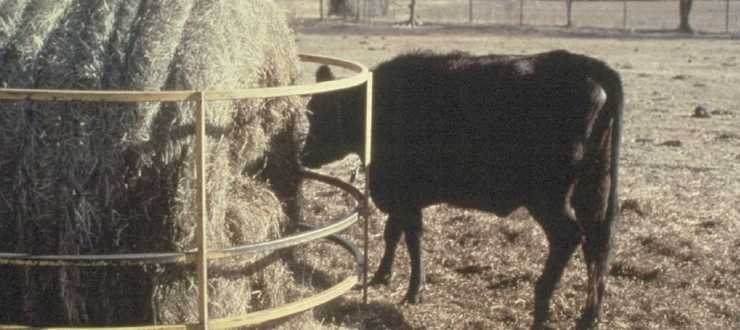
Under certain circumstances, nitrate levels in plants can build up to potentially toxic levels. This typically occurs when a relatively high level of nitrogen-containing fertilizer (60 or more units of nitrogen/acre) is applied to a forage crop, but there is poor forage growth because of an extended drought. Other stresses such as cloudy weather, excessive shading, and application of certain herbicides may also influence nitrate levels.
In grazing animals, nitrates are converted to nitrites which can “tie up” the oxygen-carrying cells in the blood. Livestock can tolerate consumption of low levels of nitrates, but once a certain threshold level is exceeded, an insufficient level of oxygen will be transmitted, which can result in cellular level suffocation. Plants containing less than 2,500 ppm (0.25%) nitrates are generally considered safe. Plants containing more than 1.5% nitrates (15,000 parts per million) are considered highly toxic.
Some plants are more likely to accumulate toxic levels of nitrates than others. The summer annual grasses (sudangrass, sorghum-sudangrass hybrids, and pearl millet) are the most common causes of this problem, but corn, wheat, and oats are also potential offenders. Some weeds, including goldenrod, smartweed, ragweed, lambsquarter, and especially pigweed can also contain toxic nitrate levels. Although rare, even bermudagrass can accumulate toxic levels of nitrates.
Animals can die after grazing high-nitrate pasture forage, but most deaths result from the feeding of high-nitrate hay. Nitrates do not degrade in hay; livestock can be poisoned in January by hay that was baled in July. In silage, nitrate levels typically decline somewhat over time.
The likelihood of death from nitrates is associated with the total amount of nitrates ingested within a given period of time. In pasture situations, livestock tends to graze several times during a 24-hour period. Even if a pasture is potentially toxic, the critical blood oxygen level deficiency may never be reached in a grazing situation due to relatively small amounts of forage being consumed at a time.
However, when potentially toxic hay is fed, animals are more likely to be hungry and they have the opportunity to consume a large amount in a relatively short period of time. This makes it much more likely that the critical intake level will be reached. When nitrate poisoning occurs, it is common for several animals to die instead of just one or two. This is because many animals typically have the same hay consumption opportunity at the same time.
Interestingly, nitrate poisoning is more common today than it was before large round bales first became popular. This is because livestock producers now tend to give animals access to more hay at one time than used to be the case when most bales were small, thus the likelihood of consuming a toxic amount of nitrates is greater.
Though most nitrate poisoning occurs during the winter hay feeding season, it is prudent to think about nitrates during hay production season. If a field that has been fertilized with a relatively high level of nitrogen fertilizer does not make much growth before being cut for hay, the hay should be tested for nitrates before feeding. This is especially true if the hay contains large quantities of the plant species listed earlier as being notorious nitrate accumulators.
Most laboratories that analyze soil sample or forage samples can check a sample for nitrates. The test is simple, inexpensive, and quick. The testing fee is a small price to pay to ensure that nitrate poisoning will not claim the lives of livestock.
Foraging Ahead is a column presented by Ragan & Massey and written by Dr. Don Ball, Professor Emeritus at Auburn University. Dr. Ball is one of the authors of the popular book “Southern Forages,” which can be found via a computer search that uses the words, “Southern Forages, The Fertilizer Institute
